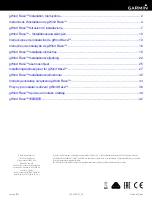
MLX90130
13.56MHz RFID Transceiver
3901090130
Page 5 of 37
Jan-2014
Rev. 004
Digital control & protocol handling
This block is responsible for the control of the device, as well as the frame coding and decoding parts of the
protocols supported by the MLX90130. The MLX90130 exchanges with the application microcontroller, pure
payload information after adding/removing frame related information such as SOF, EOF, EGT … It can also
be configured to calculate the CRC for each communication protocol.
Interface Block
The MLX90130 is addressed through SPI or UART interfaces with a specific and simple set of commands.
The built-in 528 byte buffer allows minimum interaction with the application microcontroller. This reduces the
burden of the microcontroller whose resources can be fully dedicated for the application.
Tag/Field Detector
This block manages the enhanced Tag and Field detection capabilities. It generates a detection signal that is
available for the application microcontroller through the interrupt pin IRQ_OUT. It allows the use of the
MLX90130 with low power consumption constraints.
Reference clock and internal oscillator
The built-in reference oscillator works with a reference crystal f
XTAL
of 27.12MHz from which the internal
nominal system clock frequency
f
HFO
of
13.56 MHz
is derived. An internal low frequency RC oscillator
frequency
f
LFO
of
32 kHz
is used for low-power operating modes, for example to control the internal timings.
Power management
The MLX90130 features 2 modes of operation (Active and Idle), subdivided in 5 different states of operation:
Hibernate
, the device typically consumes 1µA
Sleep
, the device typically consumes 20µA
TAG detection
, the device typically consumes 45µA.
Ready
(RF field OFF), the device typically consumes 2.5mA.
Reader
, the consumption depends on the antenna load and on the operating conditions






































